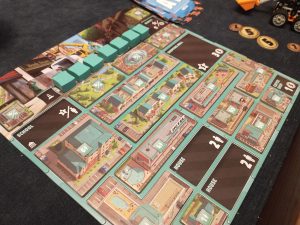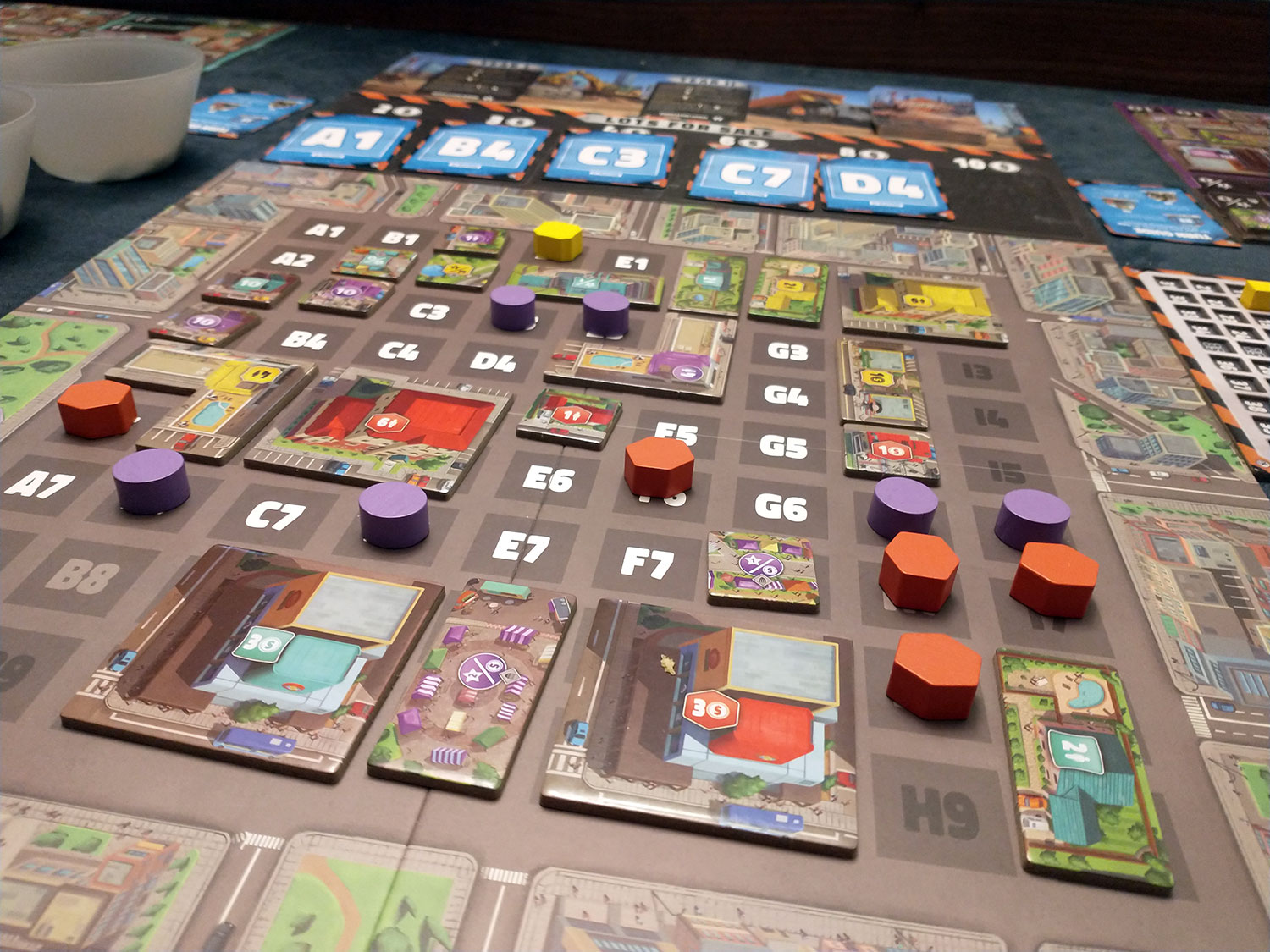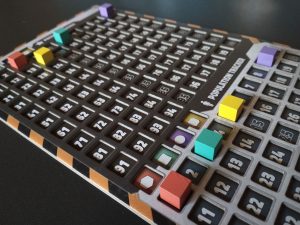 Foundations of Rome got a lot of buzz when it came out in 2022, and, as someone who grew up playing the Caesar III computer game, I was intrigued. But cool as those 3D buildings were, I had little hope of playing it, as I don’t like to spend more on games purely for production quality. I’d rather have little cardboard buildings and robust gameplay than 3D ones if it means the price is lower. Plus, I didn’t get the chance to review that one, but I have been given the opportunity to look at Foundations of Metropolis, the more frugal reskin of its stylish sibling.
Foundations of Rome got a lot of buzz when it came out in 2022, and, as someone who grew up playing the Caesar III computer game, I was intrigued. But cool as those 3D buildings were, I had little hope of playing it, as I don’t like to spend more on games purely for production quality. I’d rather have little cardboard buildings and robust gameplay than 3D ones if it means the price is lower. Plus, I didn’t get the chance to review that one, but I have been given the opportunity to look at Foundations of Metropolis, the more frugal reskin of its stylish sibling.
Foundations of Metropolis is a city-building, tile-placement game for 2-4 players with a playtime of 60 minutes.
Gameplay Overview:
In Foundations of Metropolis, players will be acquiring lots on a square grid board, on which they can later build by moving structures from their personal player boards to the owned lots. The object is to have the most points after three in-game years. Initially, players are dealt, or can draft, a hand of six lot cards. Owned lots are marked with lot markers of the player’s color. On their turn, a player may do one of three things: buy a lot, place/upgrade a building, or take income.

To buy a lot, simply pay the price listed on the space where the card you want is, take the card, and slide the remaining cards to the right, refilling the leftmost space on the lot board with a new card.
To place a building, the player must own lots in the configuration of that building. Some buildings cover a single square, others use two, three, or four lots in different configurations. You can also upgrade a building by removing it from the central board and placing a larger one, but you must own the neighboring lots required to fit the new building.
When taking income, players collect $5 plus any income they’ve revealed on their player board by removing buildings to the main board.
The game is played over the course of three in-game years. The end of a year is triggered when the last lot card from the current year stack has been purchased. At the end of each year, scoring will occur. Players score based on points they’ve uncovered on their player board, administrative building powers (these buildings score based on adjacency to other building types), and population. At the end of the third year, the player with the most points wins.

Game Experience:
Foundations of Metropolis is an easy to learn, low complexity game. Because turns involve choosing one option among just three possible actions—buy a lot, place a building, or take income—things generally move along quickly. As players get nore familiar with with the different buildings, the game pace tends to speed up; initial plays may involve longer deliberation over which building is best to place. Everyone is trying to snatch up the lots they want in order to place them in prime locations. When you buy a lot card, all cards slide to the right into cheaper slots, and a new one is placed on the left-most, pricy end of the market. This helps balance the game so that whoever gets to go next won’t always be able to afford the new card, even if it’s for a highly coveted space.

This game is really about balancing your actions. Since buildings can score off each other, there’s a hesitation early on to build because you know somebody might swoop in and place a high-scoring administrative building next to your fancy shopping mall. But you really want the additional income it will give you, so do you build anyway? There are times to hold off and wait to see what the other players will do, but if you hold off too long, the year will end and you might not get the chance to place everything you wanted to.
Meanwhile, the race for highest population (whoever has the most population gets an increasing bonus each round), tempts you to place residential buildings as well. Generally, you’ll have to lean into one strategy and might not get to place everything you want, but by the end of the game, that central board is usually mostly full. Even if you don’t get to place a building in every lot, owning them is still worth a point at the end.
This game has a player-driven tension versus a mechanical tension, where the substance of the experience is not in the deep mechanisms, but in the atmosphere of competition and teeth-grinding moments when you really don’t want somebody to buy C-5 before you do. That tension, of course, is facilitated by the game itself, but the actual decision space in the game felt limited, and some turns are simply less eventful; you just buy what’s available and affordable or just take money. I think that is an experience that will appeal to some more than others, depending on game taste.

Unfortunately, I realized this style of game doesn’t really do much for me. I craved more depth and a sense of discovery from the mechanisms themselves and felt it had little new to offer after the initial plays. At the same time, there were facets of the design I found to be fiddly and annoying. Cards are purchased frequently and while it’s fairly simple to slide the cards down and draw a new one, constantly refilling them was a minor annoyance. Scoring can also get tedious because you have to look around on the increasingly busy board for your administrative buildings to find what they’re next to and how much they score.
Would it have been better with 3D plastic buildings and a Roman theme? Honestly, I think yes, but most certainly not with such a price tag as Foundations of Rome has. For me, the Rome theme itself would have elevated the experience a little—modern city building is pretty generic—and I kind of wish this had just been a different version of the same game. It’s worth noting that all components and tiles in Metropolis are of great quality, though I did notice some of the dual-layered boards are prone to warping. But who knows, maybe for some the tactile experience of Foundations of Rome might make all the difference.
Final Thoughts:
I found myself wanting more out of this experience. There are only so many different strategies to explore, and I felt like I was just doing the obvious thing each turn. It seemed less a matter of “Which of these many things should I do?” and more like “What is the one best thing I can do?” and I don’t care for that more “on rails” approach to game design.
There is a good amount of tension between players, and I could see the appeal of that being enough for those who prefer it. Unfortunately, for me, this one just didn’t do much. I can’t deny that it’s well thought out and presented, and that Foundations of Metropolis is a generally good game, just not really one I found to be all that exciting. But the components and storage insert are top notch!
Final Score: 3 stars – A light city building game that was a little too constrained for my taste.
 Hits:
Hits:
• Excellent box insert and components
• Easy-to-grasp rules
Misses:
• Limited strategies and narrow decision space
• More form than substance
• Tedious scoring























Took us about 4/5 games to realise how deep and cut-throat it could get, positioning your buildings so that you can moved via upgrade (maybe screw someone else’s plans of scoring big if they assumed it would be there forever) and maximising how you are going to build into big scoring zones is far more nuanced than initial thought, it’s one of the games which slowly evolves as you play – at the beginning people just prioritised items in their own “zones” and quietly build their score up which makes the game very boring and obvious but after a while it gets much more aggressive (and creative) as people realise it’s the scoring pieces and their positioning (and re-positioning) that truly wins you the game rather than just churning out your own points. Our early games finished with fairly neat cities/districts but now its a true patch work as that is exactly how it looks to maximise score!
Thanks for sharing your thoughts. I agree that the main appeal of this game is in the cut-throat player interaction, which unfortunately just isn’t a play style I enjoy. I think I wanted it to be a game that allowed me to choose how I play it, kind of like how you can play Carcassonne nice or mean and still have a good time. This one, if you don’t play “mean”, just seemed to fall flat.